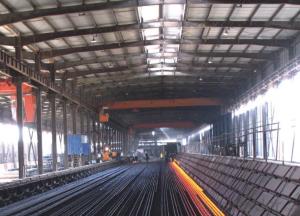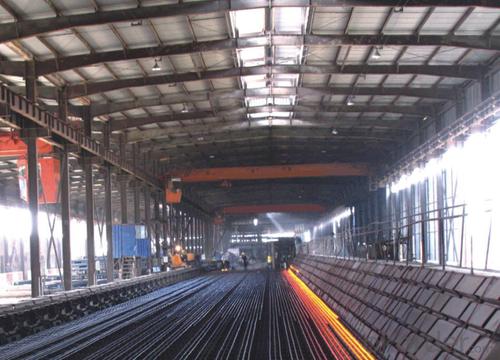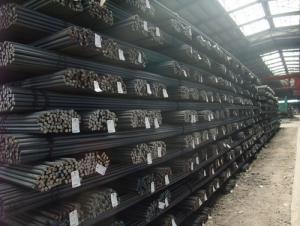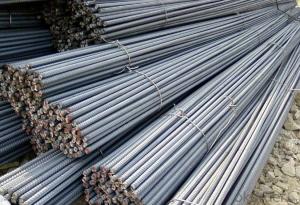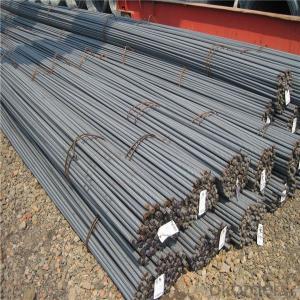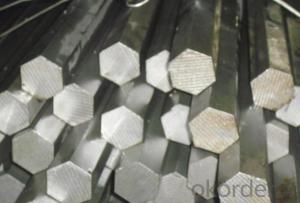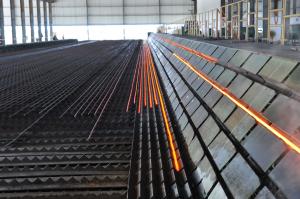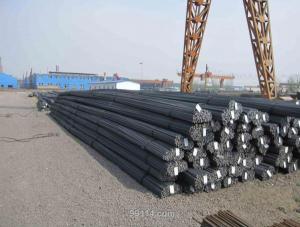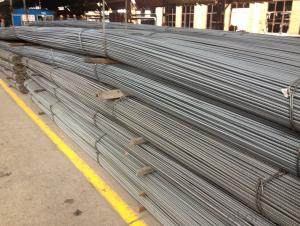Hot Rolled Deformed Steel Bar 12M Straight
- Loading Port:
- China main port
- Payment Terms:
- TT OR LC
- Min Order Qty:
- 100 m.t.
- Supply Capability:
- 100000 m.t./month
OKorder Service Pledge
OKorder Financial Service
You Might Also Like
Usage and Applications
Deformed bar is widely used in buildings, bridges, roads and other engineering construction. Big to highways, railways, bridges, culverts, tunnels, public facilities such as flood control, dam, small to housing construction, beam, column, wall and the foundation of the plate, deformed bar is an integral structure material. With the development of world economy and the vigorous development of infrastructure construction, real estate, the demand for deformed bar will be larger and larger.
Diameter(mm) | Section area (mm²) | Mass(kg/m) | Weight of 12m bar(kg) |
6 | 28.27 | 0.222 | 2.664 |
8 | 50.27 | 0.395 | 4.74 |
10 | 78.54 | 0.617 | 7.404 |
12 | 113.1 | 0.888 | 10.656 |
14 | 153.9 | 1.21 | 14.52 |
16 | 201.1 | 1.58 | 18.96 |
18 | 254.5 | 2.00 | 24 |
20 | 314.2 | 2.47 | 29.64 |
22 | 380.1 | 2.98 | 35.76 |
25 | 490.9 | 3.85 | 46.2 |
28 | 615.8 | 4.83 | 57.96 |
32 | 804.2 | 6.31 | 75.72 |
36 | 1018 | 7.99 | 98.88 |
40 | 1257 | 9.87 | 118.44 |
50 | 1964 | 15.42 | 185.04 |
Packaging & Delivery
Packaging Detail: products are packed in bundle and then shipped by container or bulk vessel, deformed bar is usually naked strapping delivery, when storing, please pay attention to moisture proof. The performance of rust will produce adverse effect.
Each bundle weight: 2-3MT, or as required
Payment term: TT or L/C
Delivery Detail: within 45 days after received advanced payment or LC.
Label: to be specified by customer, generally, each bundle has 1-2 labels
Trade terms: FOB, CFR, CIF
Cold Rolled Techniques
Yield Point: 545-565mpa
Deformed bar is widely used in buildings, bridges, roads and other engineering construction. Big to highways, railways, bridges, culverts, tunnels, public facilities such as flood control, dam, small to housing construction, beam, column, wall and the foundation of the plate, deformed bar is an integral structure material. With the development of world economy and the vigorous development of infrastructure construction, real estate, the demand for deformed bar will be larger and larger.
- Q: How do steel rebars affect the ductility of reinforced concrete?
- Steel rebars greatly enhance the ductility of reinforced concrete by providing a strong and flexible reinforcement. The rebars absorb and distribute tensile forces, preventing cracks from forming and enhancing the overall strength and durability of the concrete structure.
- Q: Can steel rebars be prefabricated off-site?
- Absolutely, steel rebars can be manufactured off-site through the process of prefabrication. This method involves creating construction components in a controlled environment that is separate from the actual construction site. Steel rebars, which are frequently used to reinforce concrete structures, can be fabricated off-site in a specialized facility. Prefabricating steel rebars off-site provides several advantages. Firstly, it enables a more efficient and streamlined manufacturing process. By working in a controlled environment, the rebars can be produced with great precision and accuracy, ensuring consistent quality. This reduces the likelihood of errors and minimizes wastage. Furthermore, manufacturing steel rebars off-site can save time during the construction phase. Since the rebars are manufactured beforehand, they can be delivered to the site ready for installation, eliminating the need for on-site fabrication. This significantly speeds up the construction process and improves project timelines as a whole. Moreover, prefabrication offers improved safety conditions. By manufacturing the rebars off-site, workers are exposed to fewer on-site hazards, such as working at great heights or in confined spaces. The controlled environment of a fabrication facility also allows for better quality control and compliance with safety regulations. Lastly, prefabrication contributes to cost savings. The efficient production process, reduced on-site labor, and improved construction timelines all help to lower overall project costs. Additionally, the controlled environment of a fabrication facility enables better utilization of materials and decreases wastage. In summary, steel rebars can indeed be prefabricated off-site, providing numerous benefits such as enhanced quality, time savings, improved safety, and cost-effectiveness. This practice is widely utilized in construction projects to optimize efficiency and ensure the highest standards of construction.
- Q: How are steel rebars used in elevator shafts?
- Steel rebars are used in elevator shafts to reinforce the concrete structure and provide strength and stability. They are embedded within the concrete walls to prevent cracking or collapsing, ensuring the safety and durability of the elevator shaft.
- Q: What is the process of bending steel rebars?
- The process of bending steel rebars involves using specialized tools and equipment to apply force and create a desired shape or angle in the steel bars. This can be done manually or with the help of machines such as hydraulic benders. The rebars are typically heated to a specific temperature to make them more malleable, and then they are carefully bent using the appropriate bending technique. The process requires skill, precision, and knowledge of the properties of steel and the desired bending specifications.
- Q: What are the different corrosion protection methods for steel rebars?
- Steel rebars commonly used in reinforced concrete structures have various corrosion protection methods available. These methods aim to prevent or minimize rebars' corrosion, which can significantly weaken the overall structure. 1. Concrete Cover: An effective corrosion protection method involves providing a sufficient thickness of concrete cover over the rebars. This creates a physical barrier, preventing the rebars from being exposed to corrosive elements. 2. Galvanization: Another method is to coat the rebars with zinc through a process called galvanization. This protective layer acts as a sacrificial anode, corroding before the rebars and enhancing their resistance to corrosion. 3. Epoxy Coating: A popular approach is applying a layer of epoxy resin over the rebars. This coating acts as a barrier, preventing moisture and corrosive substances from reaching the rebars. 4. Cathodic Protection: An electrochemical method known as cathodic protection involves using a sacrificial anode or an impressed current system. In a sacrificial anode system, a more reactive metal like zinc or magnesium is connected to the rebars, sacrificing itself to prevent corrosion. In an impressed current system, an external power source supplies a protective current to the rebars, preventing corrosion. 5. Corrosion Inhibitors: Chemicals can be added to the concrete mix or applied as a surface treatment to act as corrosion inhibitors. These substances create a protective film on the rebars' surface, blocking corrosive agents' access and preventing corrosion. 6. Stainless Steel Rebars: An effective method is to use stainless steel rebars, which have high resistance to corrosion. This makes them suitable for structures exposed to aggressive environments. It is important to consider various factors, such as environmental conditions, expected service life, and cost, when selecting the appropriate corrosion protection method. Regular inspection and maintenance of the system are also necessary to ensure its long-term effectiveness.
- Q: What is the role of steel rebars in preventing concrete spalling due to fire?
- Steel rebars play a crucial role in preventing concrete spalling due to fire by providing reinforcement and structural integrity to the concrete. When exposed to high temperatures during a fire, concrete can undergo thermal expansion, which can lead to cracking and spalling. However, the presence of steel rebars helps to restrain the expansion and prevent the concrete from breaking apart. The rebars act as a reinforcement, distributing the stresses caused by the heat and preventing the concrete from failing under the extreme conditions. Overall, steel rebars enhance the fire resistance of concrete structures and help maintain their structural integrity during a fire event.
- Q: Can steel rebars be used in retaining walls?
- Retaining walls can indeed utilize steel rebars. These rebars, also referred to as reinforcing bars, are frequently employed in retaining walls to enhance their strength and reinforcement. Typically, the rebars are embedded in the concrete or masonry structure of the retaining wall, thereby bolstering its structural integrity and fortifying it against forces like soil pressure. By incorporating steel rebars, retaining walls become resistant to cracking, shifting, or collapsing, providing a trustworthy and long-lasting solution for soil retention and erosion prevention.
- Q: Are steel rebars susceptible to magnetic fields?
- Steel rebars can be affected by magnetic fields. They are made from a ferromagnetic material, which means they can be magnetized and are attracted to magnets. This is because iron is present in the composition of steel. When steel is exposed to a magnetic field, its atoms align with the field, resulting in magnetization. However, it is worth mentioning that a strong magnetic field is usually needed to magnetize steel rebars, requiring a powerful magnet. In regular circumstances, the magnetic fields encountered are not powerful enough to considerably impact the behavior or properties of steel rebars.
- Q: What is the bending radius allowed for steel rebars?
- The bending radius allowed for steel rebars depends on various factors such as the rebar size, grade, and specific project requirements. Generally, the bending radius for steel rebars is specified by engineering standards or building codes. It is crucial to consult the relevant standards or project specifications to determine the exact bending radius allowed for steel rebars in a particular application.
- Q: How do steel rebars affect the overall crack resistance of concrete structures?
- The crack resistance of concrete structures is greatly improved by steel rebars, which have a crucial role to play. When embedded in concrete, rebars provide reinforcement and boost the tensile strength of the structure. While concrete is naturally strong in compression, it is weak in tension, and rebars help overcome this weakness by absorbing the tensile forces that may result in cracks. The inclusion of rebars in concrete structures allows for stress redistribution, thereby preventing cracks from spreading. As concrete shrinks or experiences external loads, rebars act as a reinforcement grid, effectively resisting the formation and expansion of cracks. By absorbing and dispersing the tensile stresses, rebars ensure that the concrete remains intact and can withstand heavier loads without significant cracking. Furthermore, steel rebars contribute to the overall durability of concrete structures. When rebars corrode due to exposure to moisture or other environmental factors, they can increase in volume, resulting in internal pressure and potential cracking of the concrete. However, the use of corrosion-resistant rebars, such as epoxy-coated or stainless steel rebars, can greatly reduce this risk and enhance the crack resistance of the structure. To summarize, steel rebars enhance the crack resistance of concrete structures by providing reinforcement, increasing tensile strength, redistributing stress, and preventing crack propagation. Their presence guarantees that the structure can withstand various types of loads and environmental conditions, ultimately improving the strength and durability of the concrete.
Send your message to us
Hot Rolled Deformed Steel Bar 12M Straight
- Loading Port:
- China main port
- Payment Terms:
- TT OR LC
- Min Order Qty:
- 100 m.t.
- Supply Capability:
- 100000 m.t./month
OKorder Service Pledge
OKorder Financial Service
Similar products
Hot products
Hot Searches
Related keywords
